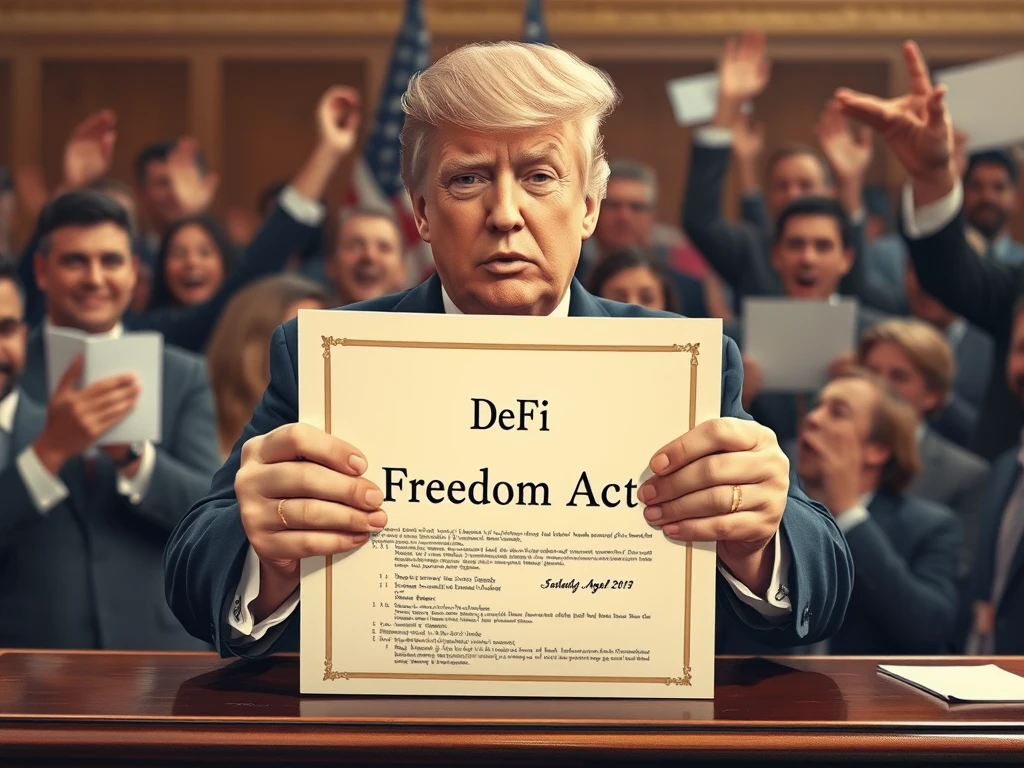Triumphant Trump Kills DeFi Broker Rule: A Massive Crypto Boost

In a stunning turn of events, former President Donald Trump has delivered a monumental victory for the cryptocurrency world by overturning the IRS’s controversial DeFi broker rule. This decisive action, celebrated across the digital asset space, signals a significant shift in US crypto regulation and has sent ripples of excitement through the decentralized finance (DeFi) sector. But what exactly does this mean for the future of DeFi, Bitcoin, and the broader crypto ecosystem? Let’s dive into the details of this game-changing development and explore its far-reaching implications.
Why is the DeFi Broker Rule a Big Deal for Crypto Regulation?
The now-defunct IRS DeFi broker rule was designed to extend traditional financial reporting requirements to decentralized finance platforms. This would have forced DeFi protocols to collect and report user transaction data, similar to how traditional brokers operate. The crypto community widely viewed this rule as a major threat to DeFi innovation for several key reasons:
- Innovation Stifling: DeFi’s core principle is decentralization and permissionless access. Imposing broker-like regulations could stifle innovation by making it harder for developers to build and operate DeFi platforms.
- Privacy Concerns: Requiring DeFi platforms to collect user data raises serious privacy concerns within a space that often prioritizes pseudonymity and decentralization.
- Technical Challenges: Implementing such rules in a decentralized environment poses immense technical challenges. DeFi protocols are often designed to be non-custodial and operate without central intermediaries, making data collection and reporting incredibly complex.
- Global Competitiveness: Overly strict regulations could push DeFi innovation and talent overseas, hindering the US’s competitiveness in the burgeoning Web3 space.
The overturning of this rule is therefore seen as a crucial step in fostering a more innovation-friendly environment for crypto regulation in the United States.
Trump Crypto Win: What Happened and Why Now?
President Trump signed a joint congressional resolution effectively nullifying the IRS DeFi broker rule. This rule, initially introduced during the Biden administration, was intended to take effect in 2027. Representative Mike Carey, a strong advocate for the resolution, stated that the DeFi Broker Rule was “needlessly hindered American innovation, infringed on the privacy of everyday Americans, and was set to overwhelm the IRS.”
This move marks the first time a crypto-focused bill has been signed into US law, signaling a potentially more favorable stance towards digital assets from the Trump administration. This “Trump crypto win” is being interpreted by many as a positive signal for the future of crypto regulation in the US, suggesting a possible shift towards policies that are more supportive of innovation and less restrictive on the DeFi sector.
Charles Hoskinson’s Perspective: Collaborative Tokenomics is Key
While the regulatory win is being celebrated, Cardano founder Charles Hoskinson offers a more nuanced perspective on the long-term success of crypto projects. Speaking at Paris Blockchain Week 2025, Hoskinson emphasized the need for “collaborative tokenomics” in the crypto space. He argues that to compete effectively with tech giants entering Web3, crypto projects must move away from adversarial, zero-sum market structures.
Hoskinson points out that the current crypto ecosystem often operates as a “circular economy,” where the growth of one token is fueled by funds exiting another. He believes that for the entire industry to thrive, projects need to adopt tokenomics and market structures that foster cooperation and mutual growth. This becomes especially crucial as major centralized tech companies like Apple, Google, and Microsoft increasingly enter the Web3 arena, backed by vast resources and established infrastructure.
Bitcoin Liquidity and Market Volatility: A Double-Edged Sword?
The article also touches upon the unique characteristic of Bitcoin liquidity – its 24/7 trading availability. While this is often touted as an advantage, it can also amplify market volatility, particularly during times of global economic uncertainty. The recent example of Bitcoin’s price drop following a US trade tariff announcement illustrates this point.
Unlike traditional markets with set trading hours, Bitcoin trades continuously. This means that during weekends or holidays when traditional markets are closed, Bitcoin can become the primary outlet for investors to react to news or market events. As Lucas Outumuro from IntoTheBlock explains, in times of panic, Bitcoin’s constant liquidity can exacerbate sell-offs as it becomes the most readily available asset to trade. Conversely, in calmer periods, this 24/7 liquidity can also contribute to price rallies.
Bybit’s Market Share Rebound After a Major Hack
In other crypto news, the article highlights Bybit’s remarkable recovery after a massive $1.4 billion hack in February. Despite suffering the largest hack in crypto history, Bybit has managed to regain its market share, returning to pre-hack levels within a short period. This recovery is attributed to Bybit’s swift implementation of enhanced security measures and improved liquidity options for traders. The exchange’s resilience underscores the importance of robust security and effective crisis management in the crypto industry.
FTX Creditors Face Deadline: KYC Verification is Crucial
Finally, the article serves as a critical reminder for FTX creditors. Nearly 400,000 users risk losing access to $2.5 billion in repayments due to failing to complete the mandatory Know Your Customer (KYC) verification process. The deadline has been extended to June 1, giving users a final opportunity to verify their identity and claim their funds. This situation emphasizes the importance of users staying informed about deadlines and fulfilling necessary requirements in complex legal and bankruptcy proceedings within the crypto space.
DeFi Market Overview: Navigating the Week’s Trends
The article concludes with a brief DeFi market overview, noting that most top cryptocurrencies experienced losses during the week. EOS and NEAR Protocol saw the most significant declines. This snapshot of market performance provides readers with a sense of the current market sentiment and volatility within the DeFi sector.
In Conclusion: A Week of Wins, Challenges, and Critical Developments
This week in crypto has been a rollercoaster of significant events. From the triumphant overturning of the DeFi broker rule – a major “Trump crypto win” – to Charles Hoskinson’s call for collaborative tokenomics, and the contrasting examples of Bitcoin’s liquidity and Bybit’s recovery, the crypto landscape continues to evolve at a rapid pace. Staying informed and understanding these diverse trends is paramount for navigating this dynamic and transformative space. The “DeFi broker rule” being killed is undoubtedly a positive step, but the industry must continue to address challenges related to regulation, security, and sustainable growth to realize its full potential.









